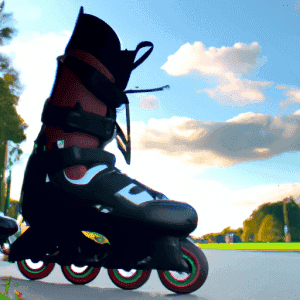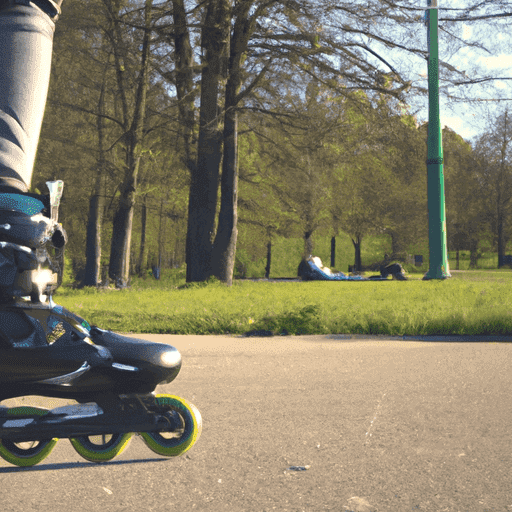Table of Contents
Table of Contents
Have you ever considered rollerblading as more than just a fun pastime? This engaging activity is not only excellent for physical fitness, enhancing strength, balance, and coordination, but it’s also a powerful tool for mental health.
From personal experiences to scientific insights, this article uncovers the surprising benefits of rollerblading that go beyond physical well-being. Whether you’re battling stress or seeking a joyful escape, discover how rollerblading can transform your life.
How Rollerblading Can Help Improve Your Mental Health
Let’s talk about rollerblading and its amazing impact on your mental health.
Seriously, it’s a game-changer! This low-impact exercise not only gets your body moving but also works wonders for your state of mind, leaving you feeling on top of the world.
One of the beautiful things about rollerblading is the rhythmic motion it offers.
As you glide along, it’s as if your body and mind sync up in perfect harmony. The result? Pure relaxation. It’s like a mini escape from the chaos of everyday life, giving you a sense of peace and tranquillity.
But it doesn’t stop there. Rollerblading is a mood-boosting machine!
When you engage in this physical activity, your body releases those magical chemicals called endorphins. They’re like little happiness superheroes that swoop in and reduce stress while making you feel downright fantastic. Trust me, it’s like having a natural mood-lifter on your side.
And let’s not forget the cherry on top: rollerblading brings you closer to the great outdoors.
Picture yourself gliding under the sun, feeling the breeze on your face—it’s pure bliss! The fresh air and sunshine work their magic to lift your spirits, leaving you with a smile that just won’t quit.
The benefits of rollerblading go beyond the mental realm and extend to your overall well-being. It’s a fantastic way to strengthen those muscles and keep your cardiovascular health in tip-top shape.
Plus, let’s not overlook the fact that it improves your balance and coordination, reducing the chances of those clumsy falls and pesky injuries.
So, my friend, it’s crystal clear that rollerblading is a remarkable way to nurture your mental health. Say goodbye to stress, embrace the joy it brings, and unlock a world of well-being. Give it a whirl and let the good times roll!
KAMUGO Kids Adjustable Helmet, Suitable for Toddler Kids Ages 2-14 Boys Girls, Multi-Sport Safety Cycling Skating Scooter Helmet
(as of 07/25/2024 14:17 GMT +01:00 - More infoProduct prices and availability are accurate as of the date/time indicated and are subject to change. Any price and availability information displayed on [relevant Amazon Site(s), as applicable] at the time of purchase will apply to the purchase of this product.)Elevate Your Fitness Game with Rollerblading: Cardiovascular Health and Beyond

Let’s talk about rollerblading and how it can rev up your heart rate and boost your cardiovascular health.
It’s a fantastic way to get that ticker pumping without putting excessive strain on your joints and muscles.
You see, rollerblading is a low-impact activity that’s gentle on your precious body.
It’s like a smooth dance that lets you burn calories and build muscle while treating your joints with kindness.
It’s a whole-body workout that does wonders for toning those legs, arms, and core muscles. Who needs a fancy gym when you’ve got a pair of trusty rollerblades?
When you’re on your rollerblades, your city or town becomes your playground.
Discover new hidden gems, cruise along scenic routes, and find the beauty in the everyday. It’s an opportunity to break away from routine and embrace the adventure that surrounds you.
Oh, and did I mention the social aspect? Rollerblading opens doors to meeting new people and creating connections that go beyond the pavement.
If you’re on the lookout for a fitness activity that ticks all the boxes—improving your cardiovascular health, burning calories, building muscle, and having an absolute blast—look no further than rollerblading.
It’s the perfect way to reach your fitness goals while enjoying every step of the journey.
OutdoorMaster Skateboard Cycling Helmet - Two Removable Liners Ventilation Multi-Sport Scooter Roller Skate Inline Skating Rollerblading for Kids, Youth & Adults
(as of 07/25/2024 14:17 GMT +01:00 - More infoProduct prices and availability are accurate as of the date/time indicated and are subject to change. Any price and availability information displayed on [relevant Amazon Site(s), as applicable] at the time of purchase will apply to the purchase of this product.)How Rollerblading Can Help You Improve Your Balance and Coordination
Picture yourself gliding along on those wheels of glory. To stay upright and keep moving forward, you need to be a master of balance and coordination.
It’s a total-body effort that engages your core, arms, and legs.
As you gain experience, you’ll find yourself picking up speed and manoeuvring with confidence.
Rollerblading requires you to tap into your core muscles, those powerful stabilizers that keep you steady as you glide.
It’s like a secret workout for your midsection, building strength while you’re having a blast. And the best part? It’s an activity for all ages and fitness levels.
So, whether you’re a rookie or a seasoned pro, rollerblading welcomes you with open wheels.
When you’re on those skates, quick adjustments are key to maintaining your balance. It’s like a dance of reflexes, where you’re constantly adapting your body position to stay upright. This dynamic movement sharpens your agility and keeps your reflexes on point.
Rollerblading doesn’t just boost your balance and coordination—it also supercharges your overall fitness. It’s a low-impact activity that gets your heart pumping and burns those calories. So, while you’re perfecting your moves, you’re also improving your overall health and fitness levels. It’s a win-win on wheels!
Rollerblading is the ultimate path to boosting your balance and coordination. It calls upon your core muscles, agility, and reflexes to keep you gliding with grace.
As you gain experience, you’ll unlock new levels of confidence and finesse. Plus, it’s an excellent way to improve your overall fitness.
Triple Eight Saver Series Pad Set with Kneesavers, Elbowsavers and Wristsavers
(as of 07/25/2024 14:17 GMT +01:00 - More infoProduct prices and availability are accurate as of the date/time indicated and are subject to change. Any price and availability information displayed on [relevant Amazon Site(s), as applicable] at the time of purchase will apply to the purchase of this product.)Shed Those Pounds with a Wheely Fun Workout: Rollerblading for Weight Loss
Rollerblading is a fantastic exercise choice for weight loss. It’s a low-impact activity that can be done indoors or outdoors, making it a flexible option that suits your preferences and circumstances.
Whether you prefer gliding through the park or exploring the smooth floors of an indoor rink, rollerblading keeps you active while reducing the risk of injury. It’s all about finding that sweet spot where fitness meets fun.
Now, let’s talk about the calorie-burning power of rollerblading. It’s a full-body workout that engages muscles in your legs, core, and arms, making sure you’re maximizing your calorie burn and fat loss potential.
As you zip along, those muscles are hard at work, torching those extra calories while toning your legs and core.
Rollerblading also gives your cardiovascular health a boost. By getting your heart rate up and blood pumping, rollerblading improves your overall cardiovascular fitness.
It’s like giving your heart a little dance party while you’re on a roll towards weight loss success.
One of the major advantages of rollerblading for weight loss is that it’s a low-impact activity. Unlike high-impact exercises like running or jogging, rollerblading is gentler on your joints.
This makes it an ideal option for those who may have joint issues or are just starting their fitness journey. You can melt away those pounds without the pounding on your precious joints.
And let’s not forget the joy factor. Rollerblading is a fun-filled activity that you can enjoy solo or with friends.
It’s a chance to escape the confines of four walls, breathe in the fresh air, and revel in the exhilaration of gliding on wheels. Plus, you can squeeze in a session anytime that fits your busy schedule.
Rollerblading is your ticket to weight loss success. It’s a low-impact, full-body workout that burns calories, melts away fat, and strengthens your muscles.
How Rollerblading Can Help You Increase Your Energy Levels
Rollerblading is an excellent way to increase your energy levels. It is a low-impact exercise that can be enjoyed by people of all ages and fitness levels.
Rollerblading is a great way to get your heart rate up and burn calories, while also providing a fun and exciting way to get some exercise.
Rollerblading is a great way to get your blood flowing and your heart rate up.
It is a cardiovascular exercise that can help you burn calories and increase your energy levels. Rollerblading is also a great way to get your body moving and your muscles working.
The motion of rollerblading helps to stretch and strengthen your muscles, which can help to improve your overall energy levels.
Rollerblading is also a great way to get some fresh air and enjoy the outdoors. Being outside in the sunshine and fresh air can help to boost your energy levels and make you feel more energized.
Rollerblading is also a great way to get some exercise without having to go to the gym.
You can rollerblade just about anywhere that there’s a flat surface
Rollerblading is also a great way to socialize and meet new people. Rollerblading with friends or family can be a great way to get some exercise and have some fun.
Rollerblading is a great way to increase your energy levels and get some exercise. It is a low-impact exercise that can be enjoyed by people of all ages and fitness levels.
80Six Dual Certified Kids Bike, Scooter, and Skateboard Helmet, Designed by Industry Leading Brand Triple 8
(as of 07/25/2024 14:17 GMT +01:00 - More infoProduct prices and availability are accurate as of the date/time indicated and are subject to change. Any price and availability information displayed on [relevant Amazon Site(s), as applicable] at the time of purchase will apply to the purchase of this product.)Conclusion
Rollerblading is a phenomenal choice for both physical fitness and mental well-being. This low-impact activity can be enjoyed in various settings, whether indoors or outdoors, making it incredibly versatile.
Beyond the physical benefits, rollerblading offers a sanctuary for your mind. It acts as a stress reliever, alleviating anxiety and helping to uplift your mood.
So, whether you choose to rollerblade on an indoor rink or venture outdoors to embrace the fresh air and sunshine, you’re making a conscious decision to prioritize your well-being. Rollerblading serves as a testament to the remarkable synergy between physical and mental health.
In a world that often feels chaotic, rollerblading offers you a haven. It’s a chance to escape the confines of routine, explore new horizons, and unlock your potential for self-discovery.





